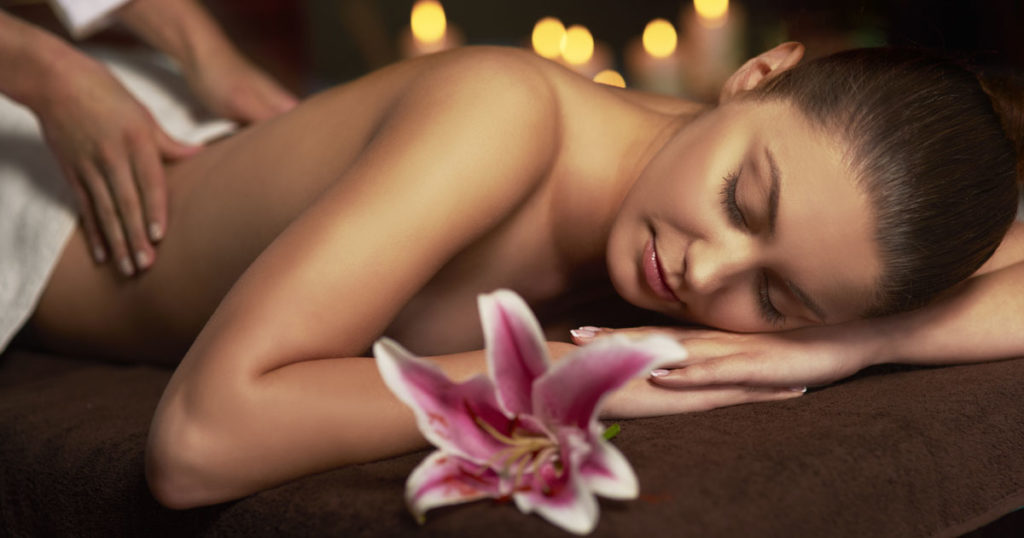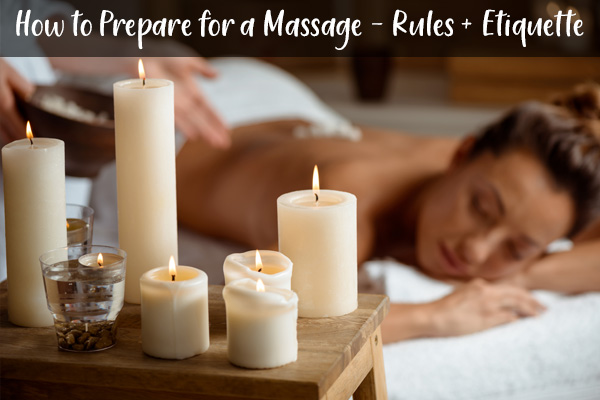When we think about a massage we often only think about the experience of a good massage and how good it will make us feel. But there are many ways we can learn how to prepare for a massage that’ll make our experience a whole lot better.
There are a number of massage rules and other massage etiquette that should be considered both before and during a massage. We’re going to discuss how to prepare for a massage and the rules and etiquette so you can have that magical and calming experience you’re wanting.
What to Do Before a Massage
There are several things that you can do to prepare for your massage while your still at home and as you are about to start your massage. Also think about what kind of massage you want – scalp massage, full body massage, Swedish massage, face massage, hot stone massage, etc. At home you should remove any jewelry or clothing that may get in the way of the massage, such as watches or tight clothing. Also, make sure you drink plenty of water before the massage to help flush out toxins and prepare your body for the massage. Practice safe hygiene for everyone involved and shower a few hours before your massage. You don’t want to shower right before you leave for it, but showing up clean is a sign of respect for your therapist and the massage space.
Start thinking about your comfort level for your massage and what you want to get out of your massage. For example, do you want a man or a woman to give you the massage. Or do you want to keep as much clothing on as possible.
As you prepare to go to your massage you want to arrive early. Show up a few minutes before your scheduled massage time to fill out any necessary paperwork and get settled in. Relax and take a few deep breaths and try to let go of any stress or tension. Lastly, before you go in for your massage you should use the restroom to avoid interruptions during the session.
Before you begin your session it is good massage etiquette to communicate your wants and needs for the session. Let the massage therapist know about any areas of concern or areas to avoid, as well as any medical conditions or allergies you may have. Also, inform the therapist of the pressure you prefer: If you prefer a lighter or stronger pressure, let your therapist know.
What to Wear For a Massage
For a traditional full-body massage you will typically disrobe and lie on a massage table covered by a sheet and blanket. The therapist will uncover only the part of the body being worked on, and will use oils or lotions to help with the massage strokes.
You could wear loose-fitting clothes that you’re comfortable in, and that you can also move easily in such as yoga pants and a tank top. If you prefer to disrobe, it is best to wear comfortable and breathable undergarments or no underwear at all. The massage therapist will provide you with a sheet or towel to drape over your body ensuring your modesty and comfort.
Ultimately, the most important thing is that you feel comfortable and relaxed during your massage so wear what makes you feel that way.

Do’s and Don’ts During Massage For a Better Experience
Massage Rules and Etiquette: What You Should Do During a Massage
1. Arrive On Time for Your Appointment
Arriving on time for a massage is important because it allows the therapist to start the session at the scheduled time and ensures that the full amount of time is available for the massage. Additionally, being late can disrupt the therapist’s schedule and negatively impact the experience for other clients. Furthermore, it is respectful to the therapist who have set aside that specific time slot for you.
2. Silence Your Phone and Be Present During the Massage
Silencing your phone during a massage is important because it helps create a peaceful and relaxing environment for both you and the therapist. The sounds and vibrations of a phone can be disruptive and can make it difficult for the therapist to concentrate on providing the best possible massage. Additionally, it can be distracting for you, making it harder for you to relax and fully enjoy the massage.
3. Follow the Therapist’s Instructions
It is important to follow a massage therapist’s instructions because they are trained professionals who have knowledge and expertise in the field of massage therapy. Following their instructions allows them to provide the best possible massage tailored to your specific needs, goals, and any medical conditions you may have. Additionally, following the therapist’s instructions can ensure your safety during the massage, such as avoiding certain positions or movements if you have an injury or medical condition.
4. Respect Your Massage Therapists Boundaries
Respecting a massage therapist’s boundaries is important because it helps create a safe and comfortable environment for both you and the therapist. Massage therapists are professionals and have a code of conduct to follow. Any violation of these boundaries can make them feel uncomfortable or even unsafe. Also, respecting the therapist’s boundaries can help maintain the integrity of the massage session allowing the therapist to focus on providing the best possible service and allowing you to relax and fully benefit from the massage. Furthermore, respecting the therapist’s boundaries helps to build trust and establish a positive relationship between the therapist and the client.
Let the Therapist Know if You Experience Any Pain or Discomfort During the Massage
This might seem somewhat obvious, but at the same time you’d be surprised how many people try to tough through the pain and don’t speak up. It’s important to let your massage therapist know if you have any pain or discomfort during a massage because it allows the therapist to adjust their technique and apply the appropriate pressure and techniques to provide the most effective and beneficial massage. It also helps the therapist to avoid any areas that may cause pain or discomfort and to work on areas that need more attention. Additionally, letting your therapist know if you have pain or discomfort can help to prevent injury or further aggravation of any existing conditions.

Massage Rules and Etiquette: What you Should Not Do During a Massage
1. Talking Excessively or Making Too Much Noise
It’s generally recommended to not talk or make too much noise during a massage because the quiet helps to create a peaceful and relaxing environment for both you and the therapist. Talking or making noise can be disruptive and can make it difficult for the therapist to concentrate on providing the best possible massage. A quiet environment also helps you to fully relax and enjoy the massage. A noisy room can be counterproductive to the goals of the massage which is to promote relaxation and reduce stress. It’s also respectful to the therapist and other clients in the room. It’s also worth noting that during a massage, therapists usually use some specific techniques that require silence in order to concentrate and to use the right pressure, so talking or making noise can interfere with the effectiveness of the massage.
2. Moving Around or Shifting Positions Excessively
Moving or shifting positions during a massage can disrupt the therapist’s flow and technique. It can also make it difficult for the therapist to maintain proper body mechanics which can lead to fatigue or injury. Additionally, staying in one position allows the therapist to work on specific areas of the body more effectively and can help to create a deeper state of relaxation. Furthermore, moving or shifting positions during a massage can also interrupt the therapist’s focus which can make the massage less effective. It is also important to communicate with your therapist if you feel uncomfortable or need to change positions so that the therapist can adjust their technique and make the necessary adjustments to ensure that you are as comfortable as possible during the massage.
3. Being Rude and Disrespectful or Making Inappropriate Requests or Comments
This is a big no-no. It isn’t appropriate to make inappropriate requests or comments or to generally be rude or disrespectful in any way during a massage. It can make the therapist feel uncomfortable and can ruin the therapeutic environment. Massage therapists are trained professionals who have boundaries, and any violation of these boundaries can be considered as sexual harassment if the comments go too far. The therapeutic relationship between the therapist and the client can deteriorate and can make the therapist uncomfortable to provide service in the future. It is important to remember that massage therapy is a professional service, and the therapist’s primary goal is to help clients relax and alleviate pain and tension. It’s important to respect the therapist and their boundaries, and to communicate any specific concerns or needs you may have in a professional and respectful manner.
4. Being Under the Influence of Drugs or Alcohol
You shouldn’t show up to your massage appointment under the influence of drugs or alcohol. It can affect your ability to relax and fully benefit from the massage, and can also be potentially dangerous for both the therapist and the client. Being under the influence can affect your ability to communicate effectively with the therapist, and can also make it harder for the therapist to adjust their technique to your specific needs.
Also, being under the influence can also put you at a higher risk of injury, as your coordination and balance may be affected. Furthermore, it can create a hostile environment and can make the therapist uncomfortable as they may feel unsafe. It’s also important to note that many massage therapists will refuse service to clients who are under the influence of drugs or alcohol, as it is a violation of their policies. It’s important to be in a clear state of mind, and to be sober in order to fully benefit from the massage.
5. Trying to Negotiate a Lower Price
When you get a massage you’re getting a service from a trained and skilled professional. It is not generally considered appropriate to try and negotiate a better price with a massage therapist. It can be seen as disrespectful to their professional services and training. Massage therapists typically set their prices based on factors such as their level of experience and the cost of running their business, and may not have flexibility to lower their prices. It is better to research and compare prices among different therapists and choose one that fits within your budget.
6. Arriving Late to an Appointment
Arriving late is against good massage etiquette and can be disrespectful to the therapist. It can disrupt their schedule and the schedule of other clients. It may also result in a shorter massage session for you as the therapist may need to end the session on time to be able to see their next client. Massage therapists typically plan their schedule carefully and arriving late can throw off their entire days schedule. We recommend arriving early to ensure that you receive the full amount of time for your massage and to be respectful of the therapist’s time and schedule.
Do You Tip Massage Therapists
Now that your session has come to an end you might be wondering if you should you tip a massage therapist. Tipping a massage therapist is not required, but it is customary to do so. Tipping is a way to show appreciation for good service, and a way to acknowledge the time, effort, and skill of the massage therapist.
The standard tip tip etiquette for massage therapy is 15-20% of the total cost of the massage, similar to other service-based industries like restaurants or hair salons. However, it’s important to consider your own budget, the cost of the massage, and the level of service you received when deciding on an appropriate tip.
If you received excellent service, it would be appropriate to tip more. On the other hand, if you were not satisfied with the service, it’s not obligated to tip. It’s also worth noting that some spas or massage facilities include gratuity in the cost of the massage, so it’s always a good idea to check beforehand.
Ultimately, tipping a massage therapist is a personal choice and should be based on your own satisfaction with the service you received.
Conclusion
Massage etiquette is a set of unwritten rules and norms that govern the behavior and conduct of clients during a massage session. This includes things like arriving on time, communicating effectively with the therapist, being respectful of the therapist’s professional boundaries, and following any instructions or guidelines provided by the therapist. Learning how to prepare for a massage is also important. It is important to be clean and prepared before the massage, and to be mindful of the therapist’s time and schedule during the session. Following these guidelines will help to ensure that the massage is a pleasant and beneficial experience for both you and the therapist.

